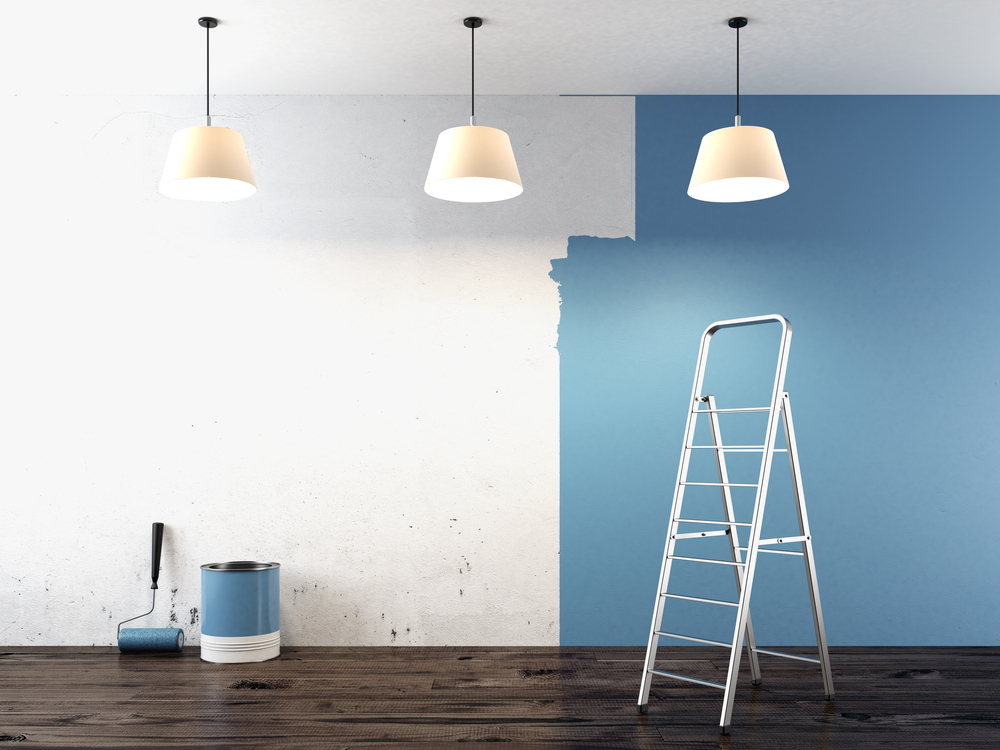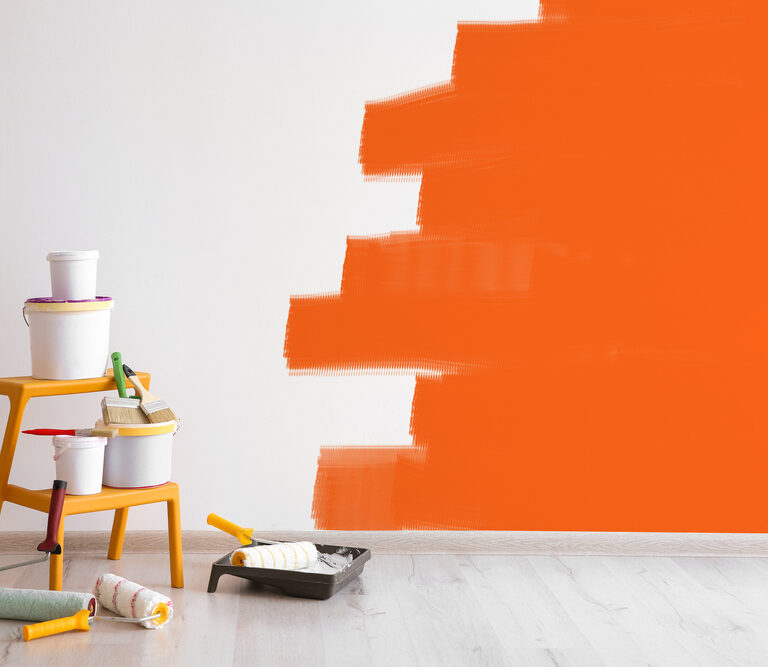The final (and arguably most exciting) part of a DIY project is painting it with the color you’ve carefully chosen. You can already see it in your mind’s eye: the sleek, new color of your bedroom walls, kitchen cabinets, or reclaimed wardrobe. You head to the warehouse to pick up that precise color combination, but then you encounter a problem.
Which Type of Paint Finish Should You Pick?
To some, choosing the kind of finish for paint seems needlessly complicated. After all, paint is paint – it can’t be more complicated than that, right? But the sheen of the paint is nearly as important as its color, since sheen directly corresponds not only to the paint’s appearance, but to its durability and longevity as well.
In this article, we’ll help you decide whether or not you should go for satin or semi-gloss for your newest painting project.
Satin vs. Semi-Gloss
There are two rules of thumb when choosing a particular paint sheen:
The first is that the shinier the paint, the stronger it will be. This is because paints with a high sheen are made with a lot more “binders” than those with less sheen. Binders are what give the paint its shininess, and are also what’s responsible for binding the pigment to the surface it’s painted on.
In other words, the shinier the paint, the more binders it has. This means it will be better at sticking to whatever surface you apply it to.
Second, the higher the sheen, the more it will reveal imperfections on the surface it’s painted on. Light tends to show imperfections much more clearly, and it just naturally draws the eye to a greater extent.
Before we discuss the specific differences between satin and semi-gloss, we’re going to tell you the basics about these two types of paint. To learn more about other types of paint finishes, you can check out our other article.
Satin
The charm of satin lies in the fact that it’s more toned-down, but still holds its own against daily wear. It has a subtle, velvet-like appearance that is extremely easy on the eyes and still manages to maintain the durability that we hold so dear.
In terms of shine, it’s right in the middle of semi-gloss and eggshell. Depending on the lighting inside the room, it could appear either glossy or flat. It’s ideal for a majority of the interior spaces of the home, such as family rooms, hallways, bedrooms, and foyers.
When it comes to drawbacks, however, satin’s only disadvantage is how hard it is to get an even finish. During application, you have to make sure that you’re painting evenly, as it’s very hard to touch-up without being obvious.
Semi-Gloss
Semi-gloss retains all the good stuff that high-gloss paints offer without the plasticky look and feel —toning down the shininess a notch. It’s still very durable and easy to clean.
This means that semi-gloss is ideal for areas that get a lot of traffic, such as the kitchen and bathroom. After all, the walls of these areas of the house frequently encounter different kinds of wear, such as grease and moisture.
The biggest flaw that semi-gloss has, however, is that it has a big tendency to reveal imperfections during application. For instance, if you’re sloppy with your rolling or brushwork or are using bad materials, the marks left from this can be easily seen on walls painted with a semi-gloss paint. To avoid this, you should always buy the best quality of applicators that your budget allows and practice painting until you’re comfortable with the motions.
How to Choose the Right Paint Finish

It’s not difficult to see why satin and semi-gloss are such popular options. They’re neither too shiny nor too glossy, which means they can fit a wide variety of painting projects. Also, both sheens are widely available in oil and latex varieties, so it’s very easy to find a good primer to pair them up with.
At the same time, the subtle differences between the two can be what turns a good project into a great one. To help you choose the best finish for your specific needs, we’re going to list the differences between satin and semi-gloss one by one.
Appearance
Appearance refers to the paint’s literal appearance on the surface of whatever it is you’re painting.
As mentioned above, semi-gloss appears glossier than satin. This is because more light is reflected by semi-gloss paint compared to satin paint, which tends to absorb light. Interestingly, this also means that the same color will appear slightly darker on a wall painted with a semi-gloss sheen than with a satin sheen.
Semi-gloss may also look a bit different painted on a wall than it does in liquid form, while satin retains the same color that it has on the can when painted on a surface. You might want to think about this when picking out a color for your painting project, to avoid any unwanted surprises.
Durability and Ease of Maintenance
Once again: the higher the sheen, the more durable and easier to clean the paint is.
So, although satin can be considered durable enough, semi-gloss is undoubtedly the sturdier option. It can handle messes, smudges, and moisture better than satin paint can. This makes it the better option for areas that receive a lot of traffic, such as kitchens, bathrooms, and children’s bedrooms or play areas.
In terms of maintenance, both paint finishes are rather resistant to dirt and easy to clean. All you need is a damp cloth, and most dirt will come off easily.
Highlighting Features
If you want to make a certain feature of your home pop out, it’s best to use paint with high reflectivity. Ideally, you should use high-gloss paint, but when comparing satin vs. semi-gloss, you should go for the latter.
To say it simply, the way the light bounces off semi-gloss paint can naturally draw the eye towards the surface that it’s painted on. This is why it’s usually used to highlight architectural features, such as crown moldings, door casings, window trims, railings, cabinets, and mantels.
Meanwhile, the dull glow of satin is more suitable for background decors, making it the frequent sheen of choice for interior walls.
You can actually use their unique features to your advantage when painting your home. Apply satin paint to nicely coat the background and semi-gloss paint to make relevant pieces pop out.
Ability to Hide Structural Imperfections
The higher the sheen, the more it will show imperfections on the painted surface.
The light reflected by the gloss will bounce and accentuate every flaw on the surface. Meanwhile, a less-reflective sheen will absorb light and make it seem as if the surface is more even than it actually is.
So, if you have a smooth, even surface, then it’s alright to use semi-gloss. But if you have an uneven surface with dents and dings, then you should go with satin.
Price
In general, glossier paints tend to be more expensive. This is due to the fact that they have more binders, and binders cost a bit more than any other materials.
Worse, they’re not just more expensive, they also cover less area per can. Glossier paints have less color-containing material (called “pigment”) in them, which means that you have to use up more paint in order to coat the same area.
So, if you’re looking to save as much money as you can, you should go for the less glossy option, which in this case is satin. That said, keep in mind that the price difference between these two, especially in smaller projects, is typically very minor. Price should only be a consideration when you’re tackling big projects, such as a full-blown house renovation.
Choosing Satin vs. Semi-Gloss
To sum up, you should choose a satin finish if you want to hide surface imperfections, save money, have a subtle background color for your rooms, and you don’t mind the inferior durability and less shiny appearance.
On the other hand, a semi-gloss finish would be best for you if you’re painting an even surface, want to make a feature pop out, need to paint a high-traffic area, don’t have any budget concerns, and like the highly reflective nature of semi-gloss.
If you’ve carefully considered these factors, then you now have no problem in choosing the sheen of your next painting project. Just remember to always be careful and wear the proper safety attire —mask, gloves, and maybe even goggles— when painting your next project.
